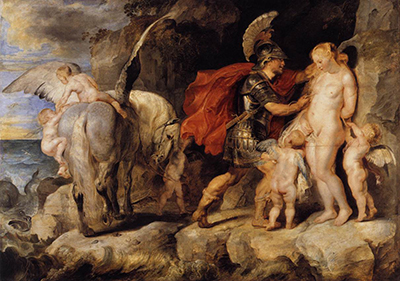Perseus Freeing Andromeda by Peter Paul Rubens was painted in 1622 as oil on panel. The painting depicts the famous Greek hero Perseus freeing Andromeda after her capture by the sea monster.
Perseus is the central figure of the painting, his red cloak contrasting vibrantly with the rest of the more neutral colour palette. He also wears his cuirass and helmet, whilst two cherubs assist him in untying Andromeda from her prison on the rock. On the left hand side of the painting, Ruben's depicts the flying horse, Pegasus, who was the mighty steed of the hero Perseus.
Two cherubs playfully sit on the winged horse's back, one helping the other to climb on top, whilst a third hold's Pegasus by the bridle. Perseus Freeing Andromeda by Peter Paul Rubens is twinned with a further painting of these two famous mythological characters, which was also painted in the same year, 1622.
Painted in the finest Baroque tradition, Perseus Freeing Andromeda by Peter Paul Rubens captures a heightened sense of movement and colour, with even the naked figures of Andromeda and the cherubs a rich mix of pinks, yellows and blue hues within their natural skin tones. The central figure of Perseus with his red cloak is clearly meant to be the stand out central figure.
The scene is deeply sensual, with Perseus the only figure fully clothed, the captive Andromeda standing fully naked waiting to be freed from her terrible captor. There is also a great deal of movement to the scene too, something that the style of Baroque was famous for. There is the obvious movement as Perseus goes to untie Andromeda, his arms outstretched, her body arched towards him.
However, the addition of the cherubs also adds further movement to the artwork too, as they assist Perseus with his heroic endeavours. The decision to include Pegasus also adds a richness of movement to the scene too, with the winged horse's tail seeming to swish away at the two cherubs who are playfully riding him, whilst the hero unties the heroine. The bowed head of the horse and the use of the bridle also gives the idea of forward motion, that every creature in the painting is on the move.
Rubens was greatly inspired by the characters of Greek mythology, and they appear as the central characters in many of his works. As a humanist scholar, Ruben's classical education informs much of his works, which were prolific, with Ruben's painting over 1,403 pieces by the time of his death in 1640.




